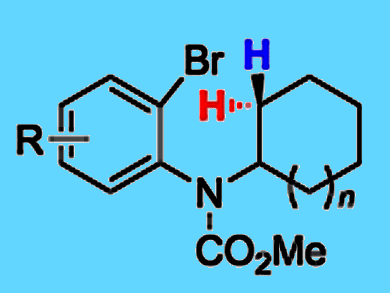Fused Indolines Made by Asymmetrical Carbon–Carbon Coupling
Many drugs are based on natural substances. Because it is usually difficult, if not impossible, to isolate these in sufficient quantities from plants or microorganisms, they must be synthesized in the laboratory. This requires linking carbon atoms – with the right spatial orientation (stereochemistry) relative to each other. In the journal Angewandte Chemie, E. Peter Kündig and a team from the University of Geneva, Switzerland, have now introduced a palladium-catalyzed synthesis that allows them to produce indoline derivatives with the correct spatial arrangement.
When synthesizing large, complex organic molecules, it is generally easier to make smaller individual pieces that can then be linked together to make the final product. The award of the 2010 Nobel Prize in chemistry to R. Heck, E. Negishi, and A. Suzuki for their work on palladium-catalyzed cross-coupling indicates the importance of methods for creating bonds between carbon atoms.
Another complication in the synthesis of natural products is that molecules with identical atomic compositions can have different spatial arrangements. This results from the chirality of carbon centers: when carbon is bound to four different partners, these can be arranged in two different ways that are mirror images of each other (chirality). When two carbon atoms are coupled together, new chiral centers may be formed. Coupling reactions that selectively deliver products with the desired spatial arrangement are thus high on the chemist’s wish list.
Kündig and his co-workers have now made a breakthrough. They have developed a new synthesis for fused indolines, a class of materials that represent an important structural motif in many natural products and pharmaceuticals, including the tumor drug Vinblastin, the antirheumatic drug Ajmalin, and the neurotoxin strychnine. Indoline is a double-ring structure consisting of one aromatic six-carbon ring and a nitrogen-containing five-membered ring; in a fused indoline, the five-membered ring is fused with an additional five- or six-membered ring.
As a starting material, the researchers used a molecule in which the central five-membered ring is still open. One of the carbon atoms to be bound was activated through binding to a bromine atom. Cleavage of the bromine and a hydrogen atom leads to ring closure. This forms a chiral center; so two different spatial arrangements of the product are possible. Thanks to a new special palladium catalyst, the researchers were able to exclusively involve only one C–H bond (of two chemically identical ones) in the reaction. Their success stems form a bulky chiral ligand, known as an N-heterocyclic carbene, which is bound to the palladium atom. The special thing about this novel catalyst is that the selectivity is maintained even at the required high temperatures around 150 °C.
- E. Peter Kündig, Université de Genève, Switzerland
- Fused Indolines by Palladium-Catalyzed Asymmetric C–C Coupling Involving an Unactivated Methylene Group,
Masafumi Nakanishi, Dmitry Katayev, Céline Besnard, E. Peter Kündig,
Angew. Chem. Int. Ed. 2011.
DOI: 10.1002/anie.201102639




